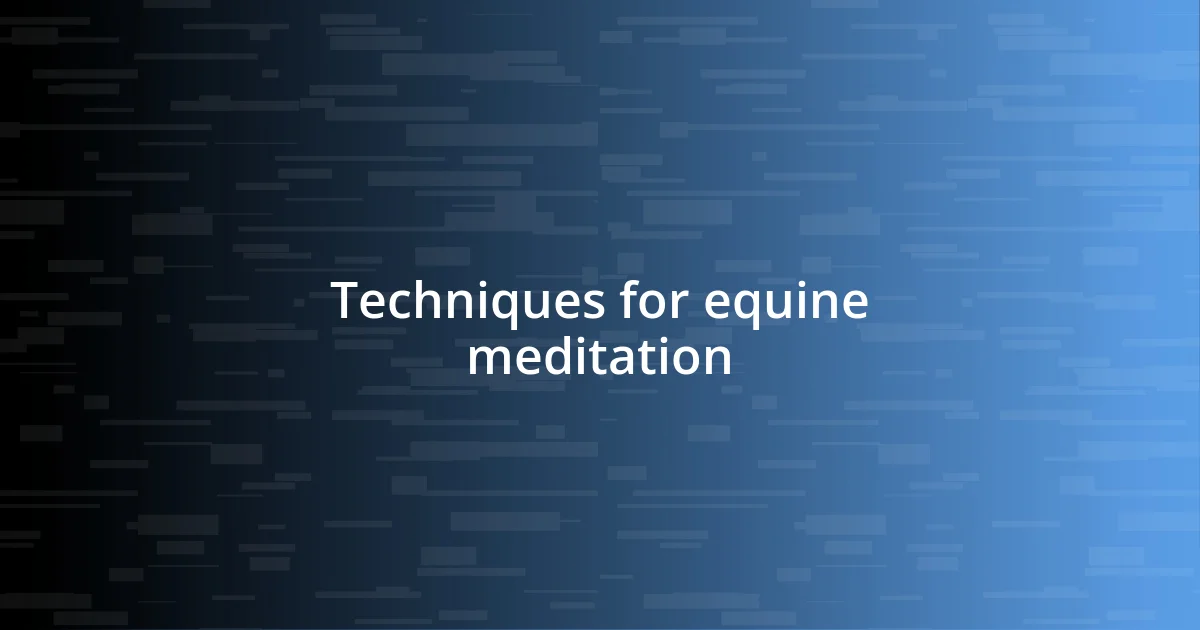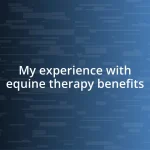Key takeaways:
- Horses provide a calming presence and can mirror human emotions, enhancing the connection and building trust, crucial for personal growth.
- Engaging in mindful activities, such as grooming and structured exercises, fosters mental clarity and self-acceptance, leading to improved focus and well-being.
- Incorporating horses into daily routines, through practices like liberty training and intentional walks, enhances emotional awareness and promotes a sense of tranquility.

Benefits of horses for therapy
When I first started working with horses, I was genuinely surprised by how calming their presence could be. Just standing next to them, feeling their warm breath and gentle movements, made my anxieties seem distant. Have you ever noticed how they seem to mirror our emotions? It’s as if they’re tuned into our feelings, providing a profound sense of connection and understanding.
Horses can also teach us valuable lessons about trust and boundaries. One time, I was working with a particularly skittish mare who wouldn’t even let me close. As I patiently gained her trust, it struck me how this process mirrored my own journey with vulnerability. Every small step reinforced my belief that therapy isn’t just about talking – it’s about building relationships, even with a horse that initially seemed so distant.
What I’ve come to appreciate is the way horses encourage us to be present. When I’m with them, I find my racing thoughts quieting down, allowing space for focused breathing and mindfulness. Have you ever tried to find clarity in a world full of distractions? Horses remind us that the act of slowing down can be incredibly therapeutic.

Understanding mental clarity
Understanding mental clarity is not merely about being free from distractions; it’s about cultivating a mindset that allows for deep focus and awareness. I remember a time when I was overwhelmed with my responsibilities, and just being around horses provided an unexpected perspective. Watching their calm demeanor, I realized that mental clarity often comes from within but can be influenced significantly by our environment.
In my experience, the mere act of grooming a horse can serve as a meditative practice. As I ran the brush over their coat, I focused solely on the rhythmic motion and the connection we shared. This simple task transformed my chaotic thoughts into a serene stream of consciousness, allowing me to find clarity amidst the noise of daily life. It’s fascinating how engaging in repetitive, mindful activities can pull us back to the present moment.
Additionally, I’ve learned that mental clarity thrives on self-acceptance. When I’m with horses, their non-judgmental nature teaches me to let go of perfectionism. There was a day when I struggled to ride one of my horses, feeling frustrated with myself. But as I looked into his gentle eyes, I understood that my journey isn’t just about achieving certain tasks; it’s about embracing the process. Such realizations are key to achieving mental clarity and well-being.
| Factors Affecting Mental Clarity | Impacts of Horses |
|---|---|
| Stress Levels | Horses reduce stress through their calm presence. |
| Focus | Grooming and caring for horses promotes mindfulness. |
| Self-acceptance | Horses encourage us to embrace our imperfections. |

Techniques for equine meditation
Techniques for equine meditation can vary, but I’ve found several methods especially effective in enhancing clarity and connection. For me, simply spending quiet time beside a horse, breathing in sync with their movements, allows me to ground myself. That moment of stillness is profound—my worries start to fade, and I feel anchored in the present. It’s like an unspoken conversation between me and the horse, where we both find peace together.
- Mindful Breathing: Inhale slowly as I watch the horse’s sides rise and fall, then exhale, letting tension slip away.
- Grooming: Engaging in the repetitive motion of brushing not only strengthens our bond but also centers my thoughts.
- Grounding Exercises: Standing barefoot in the grass while simply being in their presence connects me with nature and brings clarity.
I’ve also discovered that structured exercises can deepen the experience. I can create a simple labyrinth in the pasture and walk the path with a horse. As we move together, I focus on the rhythm of our steps, letting the journey replace racing thoughts. This practice goes beyond physical movement; it fosters a sense of harmony, allowing me to explore deeper emotional terrains that often remain unacknowledged. During one particularly memorable session, I felt a surge of clarity wash over me, like I was unraveling knots in my mind, connecting threads that once felt lost.

Building a relationship with horses
Building a connection with horses is a unique journey that transforms how we perceive ourselves and our environment. One of my most memorable moments was when I first approached a young mare named Bella. Her curiosity was palpable; she leaned forward, gently nudging me with her nose. In that instant, I felt a surge of warmth and understanding, as if she was inviting me to step into her world. Isn’t it fascinating how animals can bridge the gap of communication without uttering a word?
As I spent time with Bella, something beautiful happened: our relationship began to flourish. Horses have this incredible ability to mirror our emotions, which makes building trust paramount. I remember once when I was feeling particularly anxious. Bella sensed my unease and responded with calmness, standing quietly beside me. It was a reminder that establishing a relationship is about being vulnerable and open. Have you ever experienced such a moment where simply being with someone—human or animal—allowed you to let down your guard?
Caring for horses creates an unspoken bond that goes beyond mere interaction. Whether it’s the simple act of feeding them or sharing quiet moments in the field, I’ve realized that this relationship demands patience. I’ve spent countless hours just observing how they interact with each other. It taught me that relationships, like those with horses, thrive on trust and respect. The more I invest my time and heart into building this connection, the richer my experience becomes. Each encounter leaves me reflecting on the depth of our bond and the clarity I find in those shared moments.

Exercises for enhancing focus
To enhance my focus, I’ve found that incorporating movement with intention makes a difference. One exercise I love is walking in a circle with a horse, each step mirroring their gait. As we move together, I tune into my surroundings, forcing myself to remain present. The rhythm helps to quiet my mind—have you ever noticed how the act of mindful walking can clear mental fog?
Another technique that truly resonates with me is when I use simple objects like cones or small flags to create an obstacle course in the pasture. Navigating this course with a horse requires concentration—not just on the path but also on how my horse reacts to each turn. I remember one day, during an exercise like this, my horse started to speed up unexpectedly. It made me think about how I need to remain adaptable and focused, both on the course and the horse’s behavior. This was a beautiful reminder: focus isn’t just about what you want to do; it’s about how you respond in the moment.
Then there’s a grounding technique I often return to whenever I feel scattered. I sit quietly at the edge of the pasture, surrounded by horses. I close my eyes and listen intently to their sounds—the rustling of their manes, the soft nicker of communication between them. This immersive experience helps me shed distractions and reconnect with my breath. It’s like tuning into a live symphony, with nature conducting. Have you ever found clarity simply by tuning out the world around you? It feels powerful, doesn’t it?

Reflection practices after riding
After a ride, I often find myself reflecting in a peaceful spot, allowing the events of the day to soak in. During one particularly intense session with Leo, my spirited gelding, I sat under a nearby tree, reliving our ride. It was incredible to notice how my nerves settled as I took those moments to digest what we experienced together. How often do we pause to truly reflect on what we’ve just done?
I’ve learned to jot down my thoughts, which has created a deeper understanding of my rides. The other day, after a long canter, I wrote about how our communication improved. I could feel Leo respond to my cues better than before, and it struck me that reflection isn’t merely about what went well; it’s a canvas for growth. Have you ever captured your ride on paper? It can reveal patterns and insights you might overlook otherwise.
In looking back on my experiences, I’m reminded of how each ride teaches me something new—not just about riding, but about myself. There’s a special clarity that arises when I let my mind wander over the journey we took. I recently realized that the freedom I felt in the saddle mirrored the growing confidence I have in my own life. Isn’t it remarkable how horses can serve as mirrors, reflecting our inner thoughts and feelings?

Incorporating horses in daily life
Incorporating horses into my daily routine often feels like an organic flow rather than a chore. For instance, each morning, I make it a point to spend time with my horses before I dive into the busyness of the day. I find that simply grooming them can be a meditative practice. The rhythmic motion of brushing and the subtle connection I build with each horse helps ground me for whatever lies ahead—have you ever noticed how small moments can shift your mindset dramatically?
I also like to take my horses on short, intentional walks when I need a mental reset. During one such outing with Daisy, my gentle mare, I felt stress melting away as we ambled through the fields. Her calm nature acted as a soothing balm for my racing thoughts. I can’t help but wonder: have you experienced that kind of peaceful presence from an animal before? It’s almost like they sense our energy and help recalibrate it.
Occasionally, I set aside time for more structured activities, like liberty training, where my horse and I engage without a halter or lead. This open communication fosters trust and allows me to observe my own emotional state—am I anxious, excited, or relaxed? The other day, while practicing this with Max, I realized how my nerves translated to him. It reminded me that our emotional states can heavily influence those around us. This connection is invaluable; it underscores how I can be more mindful of my own emotions in everyday life.














